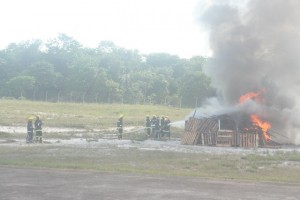
The Cheddi Jagan International Airport (CJIA) on Wednesday conducted a simulation exercise involving more than 300 persons inclusive of airport, airline, hospital, fire service and other emergency personnel, testing their readiness to respond to an emergency.
Public Works Minister Robeson Benn, who witnessed the full-scale emergency exercise, explained that it is staged every two years, and is a requirement of the International Civil Aviation Organisation (ICAO).
“These simulations are part of the certification requirements for an international airport. So every six months, there is table-top exercise, every year there is a partial simulation exercise, and every two years there is a mass casualty exercise simulation, which today’s event [a fake plane crash] was about,” he said on Wednesday.
Benn explained that the exercise was done to make sure that the airport, its operatives and all the resources which ought to be called upon for an event of the kind that was simulated are able to respond quickly, with the proper resources, knowledge and expertise to help the injured or traumatised.
The Guyana Fire Service (GFS); the Guyana Defence Force (GDF) Customs and Immigration; the Health Ministry; the Guyana Civil Aviation Authority; the Guyana Red Cross; and the Guyana Police Force (GPF) were among the stakeholders involved in the mock exercise.
Minister Benn explained that evaluators from the ICAO would have observed the exercise and evaluated it “dispassionately” to assess the performance of all involved.
The minister noted that there were some aspects in the exercise where “more energy and assertiveness and control” could have been had, the Government Information Agency (GINA) reported.
Chief Medical Officer Dr Shamdeo Persaud believes the exercise went smoothly.
“I think it worked well, with everyone being clear about their responsibilities on how to contribute in a crisis,” he said. He pointed out that success in such health crisis exercises is very dependent on how well organised the response is, and how smoothly the response personnel move the persons who are assessed to be critical to care facilities.
Dr Persaud particularly praised the high level of response of the medical personnel from the Diamond and Georgetown hospitals.
Dr Persaud noted that the staff responded immediately to their signals. “I think that was good that the local medical personnel were able to respond so quickly. All three sites responded adequately,” he said.
Planned logistics
According to the planned logistics, in the eventuality of a real crash, both Diamond and Georgetown hospitals must send an ambulance, as well as some support medical staff.
The exercise began with the GFS first arriving at the crash scene and putting out the fire created by the crash.
The firefighters also did the initial extraction of the ‘passengers’ from the crash site to a collection area. The persons were then moved from there to a triage area that was set up by the GDF, the second responders to the crash.
Dr Persaud said the triage area was to allow the health workers to function, up to standard and away from the danger of the crash site. He explained that the triage area is to provide immediate treatment and to sort and tag persons into three broad groups – dead, critical and not so critical.
The crash victims were then moved to a more organised care area before being transported to nearby hospitals.
Preparation for the simulation exercise began almost six months ago.



